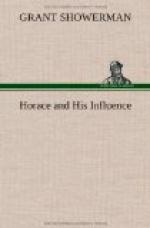A glance at the use of Horace in Spain will afford not the least edifying of modern examples. The inventories of Spanish libraries in the Middle Age rarely contain the name of Horace, or the names of his lyric brethren, Catullus, Tibullus, and Propertius. Virgil, Lucan, Martial, Seneca, and Pliny are much more frequent. It was not until the fifteenth century that reminiscences of the style and ideas of Horace began to appear in quantity. Imitation rather than translation was the vehicle of Spanish enthusiasm. The fountain of Horatianism in Spain was the imitation of Epode II, Beatus Ille, by the Marquis de Santillana, one of Castile’s two first sonneteers, in the first half of the fifteenth century. Garcilaso also produced many imitations of the Odes. The Horatian lyric seemed especially congenial to the Spanish spirit and language. Fray Luis de Leon, of Salamanca, the first real Spanish poet, and the most inspired of all the Spanish lovers of Horace, was an example of the poet translating the poet where both were great men. He not only brought back to life once more “that marvelous sobriety, that rapidity of idea and conciseness of phrase, that terseness and brilliance, that sovereign calm and serenity in the spirit of the artist,” which characterized the ancient poet, but added to the Horatian lyre the new string of Christian mysticism, and thus wedded the ancient and the modern. “Luis de Leon is our great Horatian poet,” says Menendez y Pelayo. Lope de Vega wrote an Ode to Liberty, and was influenced by the Epistles. The Flores de Poetas ilustres de Espana, arranged by Pedro Espinosa and published in 1605 at Valladolid, included translations of eighteen odes. Hardly a lyric poet of the eighteenth century failed to turn some part of Horace into Spanish. Salamanca perfected the ode, Seville the epistle, Aragon the satire. Mendoza in his nine Epistles shows his debt to Horace. In 1592, Luis de Zapata published at Lisbon a not very successful verse translation of the Ars Poetica. In 1616, Francisco de Cascales of Murcia published Fablas Poeticas, containing in dialogue the substance of the same composition, which had been translated by Espinel, 1551-1624, and which was translated again in 1684, twice in 1777, and in 1827. Seville founded a Horatian Academy. The greatest of the Spanish translators of Horace entire was Javier de Burgos, whose edition of four volumes, 1819-1844, is called by Menendez y Pelayo the only readable complete translation of Horace, “one of the most precious and enviable jewels of our modern literature,” and “perhaps the best of all Horaces in the neo-Latin tongues.” The nearest rival of Burgos was Martinez de la Rosa. The greatest Spanish scholar and critic of Horace is Menendez y Pelayo, editor of the Odes, 1882, and author of Horacio en Espana, 1885.




